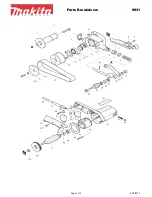
3. SPECIFICATION
Model No:
.....................................................................
OS400
Motor Power: ...................................................................
400W
N
oise Power/Pressure:
...........................................
88/77dB(A)
No-Load Speed: .............................................. 4000-10000rpm
O
rbit Size:
.......................................................................Ø5mm
P
ad Size:
....................................................................Ø150mm
Supply: ............................................................................. 230V
T
hread Size:
.........................................................................M8
V
ibration/Uncertainty:
..............................................
9.6/1.5m/s²
4. OPERATION
WARNING!
Before use, ensure that you have read and
understood Section 1 Safety Instructions.
NOTE:
The sander is designed for dry use only.
8
DO NOT
use with water or any other liquids.
4.1.
INSTALL HOOK AND LOOP BACKPLATE
4.1.1.
With the tool unplugged from the power supply, place it on a tool rest with the spindle upright.
4.1.2.
Firmly attach backplate to the machine spindle using bolt and hex key supplied while ensuring engagement of hexagonal spindle.
4.1.3.
Attach sanding disc to backing plate ensuring it is centred. If using sanding discs with holes, align the holes on disc and backing
plate to aid dust extraction.
4.2.
STARTING AND STOPPING
4.2.1.
Plug the sander into the power supply.
4.2.2.
The sander has a six position speed controller numbered 1 to 6 offering speeds from 4000 to 10,000 RPM (fig.1).
4.2.3.
Set speed control to required value and pull the trigger to start. To stop the machine release the trigger.
4.2.4.
For continuous operation press the switch lock button to lock the trigger (fig.1). Pull the trigger again to stop the tool.
4.3.
DUST COLLECTION
4.4.
The sander is equipped with a multi-holed backing plate.
4.4.1.
Dust collection can be enhanced by use of sanding discs with corresponding holes.
4.4.2.
Align the holes when attaching sanding disc to the backing plate.
4.4.3. The sander has a self-vacuum function which, when connected to either a dust collection bag or vacuum cleaner, can improve
dust collection. (Rubber connector supplied)
5. MAINTENANCE
WARNING!
Disconnect sander from power supply before changing accessories, servicing or performing maintenance. Replace or repair
any damaged parts. Use genuine parts only, unauthorised parts may be dangerous and will invalidate the warranty.
5.1.
After each 50 hours use (or as required), remove dust by blowing air through the side vents and around the pad bearing. Regular
cleaning will prolong the life of the sander.
5.2.
Change pads when required. Ensure pad and disc RPM ratings are equal to, or exceed the machine rating. If the disc becomes
unbalanced, it will cause the bearings to wear. To change the backing pad remove the backplate using the hex key.
Replace the pad and secure (Section 4.1).
5.3.
When not in use store in a safe, dry, childproof location.
5.4.
All other service and maintenance be carried out by an authorised Sealey stockist.
WARNING! – Risk of Hand Arm Vibration Injury.
This tool may cause Hand Arm Vibration Syndrome if its use is not managed adequately.
This tool is subject to the vibration testing section of the Machinery Directive 2006/42/EC.
This tool is to be operated in accordance with these instructions.
Measured vibration emission value (a): 9.6m/s²
Uncertainty value(k): 1.5m/s²
Please note that the application of the tool to a sole specialist task may produce a different average vibration emission. We recommend
that a specific evaluation of the vibration emission is conducted prior to commencing with a specialist task.
A health and safety assessment by the user (or employer) will need to be carried out to determine the suitable duration of use for each
tool.
NB:
Stated Vibration Emission values are type-test values and are intended to be typical.
Whilst in use, the actual value will vary considerably from and depend on many factors.
Such factors include; the operator, the task and the inserted tool or consumable.
NB:
ensure that the length of leader hoses is sufficient to allow unrestricted use, as this also helps to reduce vibration.
The state of maintenance of the tool itself is also an important factor, a poorly maintained tool will also increase the risk of Hand Arm
Vibration Syndrome.
Health surveillance.
We recommend a programme of health surveillance to detect early symptoms of vibration injury so that management procedures can be
modified accordingly.
Personal protective equipment.
We are not aware of any personal protective equipment (PPE) that provides protection against vibration injury that may result from the
uncontrolled use of this tool. We recommend a sufficient supply of clothing (including gloves) to enable the operator to remain warm and
dry and maintain good blood circulation in fingers etc. Please note that the most effective protection is prevention, please refer to the
Correct Use and Maintenance section in these instructions. Guidance relating to the management of hand arm vibration can be found on
the HSC website
www.hse.gov.uk - Hand-Arm Vibration at Work.
Original Language Version
© Jack Sealey Limited
fig.1
O
S400 Issue:2 (F) 20/10/21






















